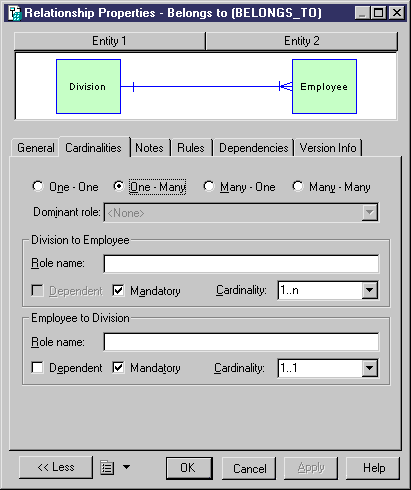

Chapter 4 Building Conceptual Data Models
Cardinality indicates the number of instances (none, one, or many) of an entity in relation to another entity. You can select the following values for cardinality:
| Cardinality | Symbol | Description |
|---|---|---|
| One-to-one | <1..1> | One instance of the first entity can correspond to only one instance of the second entity |
| One-to-many | <1..n> | One instance of the first entity can correspond to more than one instance of the second entity |
| Many-to-one | <n..1> | More than one instance of the first entity can correspond to the same one instance of the second entity |
| Many-to-many | <n..n> | More than one instance of the first entity can correspond to more than one instance of the second entity |
The Cardinalities page contains a groupbox for each direction of the relationship. The title of the groupbox takes the following form:
'EntityA' to 'EntityB'
The following properties apply to each direction of the relationship:
| Property | Description |
|---|---|
| Dominant role | In a One to One relationship, indicates to generate a reference in the PDM for this direction of the relationship only |
| Role name | Text that describes the relationship of EntityA to EntityB |
| Dependent | Indicates that each instance of the EntityA is identified by an instance of EntityB |
| Mandatory | Indicates that each instance of the EntityA requires an instance of the EntityB |
| Cardinality | Maximum and minimum number of instances of EntityA in relation to EntityB (if mandatory, at least 1). You can indicate the following cardinalities:
0..1 0..n 1..1 1..n |
In a diagram, termination points indicate cardinality at each end of a relationship. A termination with a single contact point denotes a cardinality of one. A termination with three contact points denotes a cardinality of many.
| Termination point | Cardinality |
|---|---|
| One | |
| Many |
For more information on IDEF1X cardinality notation, see section CDM options in chapter Conceptual Data Model Basics.
![]() To define cardinality:
To define cardinality:
The Cardinalities page below indicates that an employee must belong to one and only one division, while a division must include one or more employees.

| Copyright (C) 2005. Sybase Inc. All rights reserved. |

| |